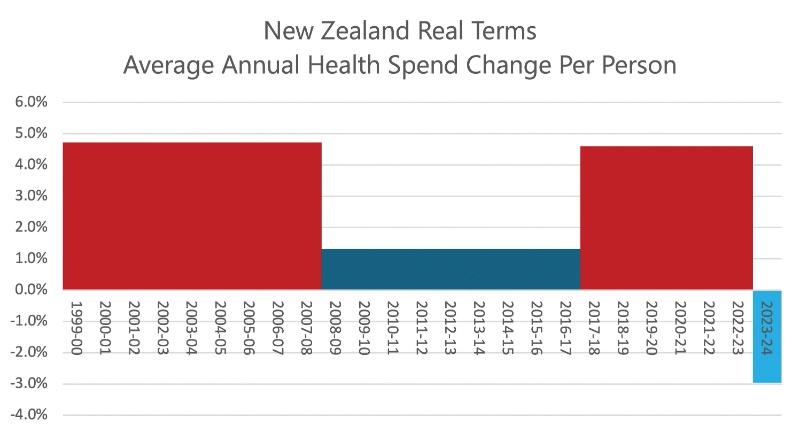Budget 2024: Delivering On Promises – Just – While Standing On Quicksand
- The Government delivered on its election promises in Budget 2024, with tax cuts presented as campaigned. But can they keep to their word and new projections? They’re walking a fine line.
- Treasury’s forecasts have softened yet again. High interest rates, still-high inflation, weakening demand and falls in productivity are dragging the Kiwi economy.
- A weaker economic outlook means a weaker fiscal outlook. No surprises. The Government’s books are in a worse state as revenue growth underperforms. And that’s despite a reduction in operating allowances. Deeper operating deficits in the near-term and a return to surplus – only just.
- Government’s debt pile continues to grow in the near-term. The peak remains at 43.5%, but is reached a year later in the 2028 fiscal year. More debt means more issuance - $12bn more over the next four years to be precise.
- For the RBNZ, Treasury’s updated fiscal impulse is key. And it appears fiscal consolidation too has been delayed. Fiscal settings are less tight than assumed in December. That doesn’t help the RBNZ’s quest in tackling the inflation beast.
Budget 2024 delivers on election promises, just. Fiscal neutrality was a key consideration, as revenue projections suffer from a bleaker reality.
Finance Minister, Nicola Willis, must feel like she's standing on quicksand. The economy is smaller than expected, and the outlook received a downgrade. That means the actual tax take, and the forecast tax take, keep sinking.
The numbers are softer across the board. Treasury expect lower growth, weaker productivity, and more debt. Economic growth starts to lift, off a lower base, into 2025, but hardly shoot the lights out beyond. The operating surplus is achieved, on paper, in 2028 - at the very end of the projections. The weaker reality means more debt. The debt management office will have to issue an additional $12bn beyond 2025 and out to 2028. Net debt rises to 43.5% and remains above previous projections.
It’s a difficult budget for any Government to deliver. We've been through a recession, so the temptation is to expand and spend. But inflation remains too high and the RBNZ is on the war path with restrictive interest rates. So, delivering a fiscally expansive budget would have fuelled inflation and poked the RBNZ bear.
The Government did a good job on delivering what was expected, and not much more. The promised tax cuts were delivered, as said, and appear to be fiscally neutral. That means they gave (tax cuts) with one hand, and took (spending cuts and some other tax hikes) with the other hand.
In terms of headline-grabbing announcements, the Government’s tax relief package was front and centre. From 31 July this year, New Zealand will be ushering in a new set of personal income tax thresholds. Alongside income tax, the Government increased the Working for Families in-work tax credit, and the income cap for the Independent Earner Tax Credit will increase. As announced at the mini-Budget, the Government’s tax relief package also extends to property investors. The Government has restored interest deductibility for residential rental property (full restoration from April 2025), and reduced the Brightline test for rental properties to two years from 10 years (effective from 1 July 2024). All up, the Government’s tax package will cost $3.7bn. But savings and other revenue initiatives are covering the bill, rather than additional borrowing.
As earlier signalled, Budget 2024 provides a top up to the multi-year capital allowance (MYCA) by $7bn. There’s now $7.5bn in the jar to fund future investment projects. Key investments as outlaid in the budget build on the existing capital pipeline. A couple to note is the $1.2bn set aside for the Regional Infrastructure Fund with an $200mn initial investment in to flood resilience infrastructure. And revamping our roads, rail and public transport received an almost $3bn cheque.
A $8.15bn was directed to health over the next four years, albeit mainly to cover cost pressures. And $3bn goes toward education largely for the creation of new schools and classrooms.


 Gordon Campbell: On The Americanising Of NZ’s Public Health System
Gordon Campbell: On The Americanising Of NZ’s Public Health System New Zealand Deerstalkers Association: NZDA Urges Hunters To Prioritise Safety This Roar Season
New Zealand Deerstalkers Association: NZDA Urges Hunters To Prioritise Safety This Roar Season PSA: 1000 Days Since Landmark Pay Equity Deal Expired - Workers Losing $145 A Week
PSA: 1000 Days Since Landmark Pay Equity Deal Expired - Workers Losing $145 A Week Grace Tinetali-Fiavaai, RNZ: Widow Of Fa'anānā Efeso Collins Seeks Inquiry Into His Death - 'Unanswered Questions'
Grace Tinetali-Fiavaai, RNZ: Widow Of Fa'anānā Efeso Collins Seeks Inquiry Into His Death - 'Unanswered Questions' Te Pāti Māori: Te Pāti Māori Call For Mandatory Police Body Cameras
Te Pāti Māori: Te Pāti Māori Call For Mandatory Police Body Cameras NZ First Party: NZ First Introduces the “Conscience Acts Referendums Bill”
NZ First Party: NZ First Introduces the “Conscience Acts Referendums Bill” NZ Government: Unlocking Data To Increase Competition And Choice
NZ Government: Unlocking Data To Increase Competition And Choice


